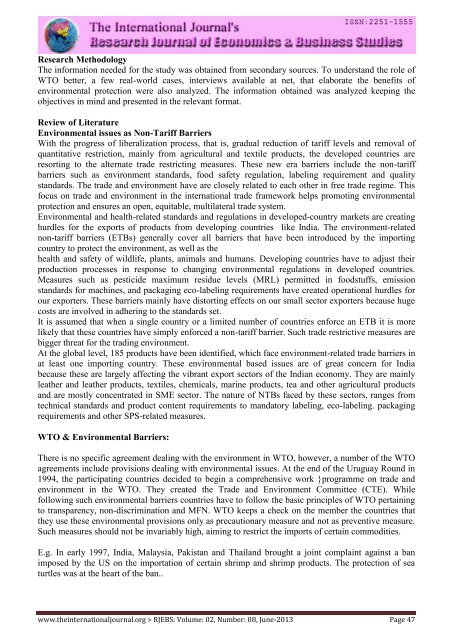Research Journal of Economics & Business Studies - RJEBS - The ...
Research Journal of Economics & Business Studies - RJEBS - The ...
Research Journal of Economics & Business Studies - RJEBS - The ...
- No tags were found...
Create successful ePaper yourself
Turn your PDF publications into a flip-book with our unique Google optimized e-Paper software.
<strong>Research</strong> Methodology<br />
<strong>The</strong> information needed for the study was obtained from secondary sources. To understand the role <strong>of</strong><br />
WTO better, a few real-world cases, interviews available at net, that elaborate the benefits <strong>of</strong><br />
environmental protection were also analyzed. <strong>The</strong> information obtained was analyzed keeping the<br />
objectives in mind and presented in the relevant format.<br />
Review <strong>of</strong> Literature<br />
Environmental issues as Non-Tariff Barriers<br />
With the progress <strong>of</strong> liberalization process, that is, gradual reduction <strong>of</strong> tariff levels and removal <strong>of</strong><br />
quantitative restriction, mainly from agricultural and textile products, the developed countries are<br />
resorting to the alternate trade restricting measures. <strong>The</strong>se new era barriers include the non-tariff<br />
barriers such as environment standards, food safety regulation, labeling requirement and quality<br />
standards. <strong>The</strong> trade and environment have are closely related to each other in free trade regime. This<br />
focus on trade and environment in the international trade framework helps promoting environmental<br />
protection and ensures an open, equitable, multilateral trade system.<br />
Environmental and health-related standards and regulations in developed-country markets are creating<br />
hurdles for the exports <strong>of</strong> products from developing countries like India. <strong>The</strong> environment-related<br />
non-tariff barriers (ETBs) generally cover all barriers that have been introduced by the importing<br />
country to protect the environment, as well as the<br />
health and safety <strong>of</strong> wildlife, plants, animals and humans. Developing countries have to adjust their<br />
production processes in response to changing environmental regulations in developed countries.<br />
Measures such as pesticide maximum residue levels (MRL) permitted in foodstuffs, emission<br />
standards for machines, and packaging eco-labeling requirements have created operational hurdles for<br />
our exporters. <strong>The</strong>se barriers mainly have distorting effects on our small sector exporters because huge<br />
costs are involved in adhering to the standards set.<br />
It is assumed that when a single country or a limited number <strong>of</strong> countries enforce an ETB it is more<br />
likely that these countries have simply enforced a non-tariff barrier. Such trade restrictive measures are<br />
bigger threat for the trading environment.<br />
At the global level, 185 products have been identified, which face environment-related trade barriers in<br />
at least one importing country. <strong>The</strong>se environmental based issues are <strong>of</strong> great concern for India<br />
because these are largely affecting the vibrant export sectors <strong>of</strong> the Indian economy. <strong>The</strong>y are mainly<br />
leather and leather products, textiles, chemicals, marine products, tea and other agricultural products<br />
and are mostly concentrated in SME sector. <strong>The</strong> nature <strong>of</strong> NTBs faced by these sectors, ranges from<br />
technical standards and product content requirements to mandatory labeling, eco-labeling. packaging<br />
requirements and other SPS-related measures.<br />
WTO & Environmental Barriers:<br />
<strong>The</strong>re is no specific agreement dealing with the environment in WTO, however, a number <strong>of</strong> the WTO<br />
agreements include provisions dealing with environmental issues. At the end <strong>of</strong> the Uruguay Round in<br />
1994, the participating countries decided to begin a comprehensive work }programme on trade and<br />
environment in the WTO. <strong>The</strong>y created the Trade and Environment Committee (CTE). While<br />
following such environmental barriers countries have to follow the basic principles <strong>of</strong> WTO pertaining<br />
to transparency, non-discrimination and MFN. WTO keeps a check on the member the countries that<br />
they use these environmental provisions only as precautionary measure and not as preventive measure.<br />
Such measures should not be invariably high, aiming to restrict the imports <strong>of</strong> certain commodities.<br />
E.g. In early 1997, India, Malaysia, Pakistan and Thailand brought a joint complaint against a ban<br />
imposed by the US on the importation <strong>of</strong> certain shrimp and shrimp products. <strong>The</strong> protection <strong>of</strong> sea<br />
turtles was at the heart <strong>of</strong> the ban..<br />
www.theinternationaljournal.org > <strong>RJEBS</strong>: Volume: 02, Number: 08, June-2013 Page 47

















